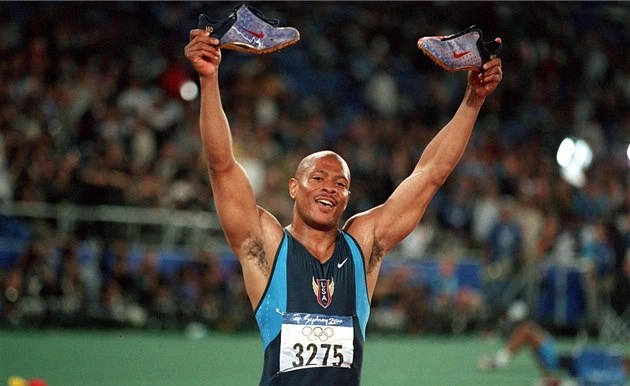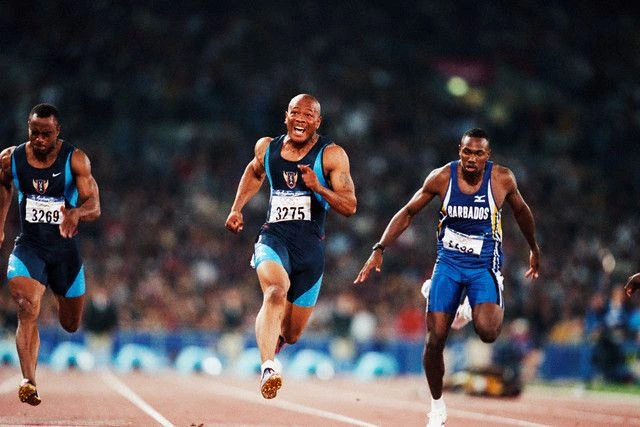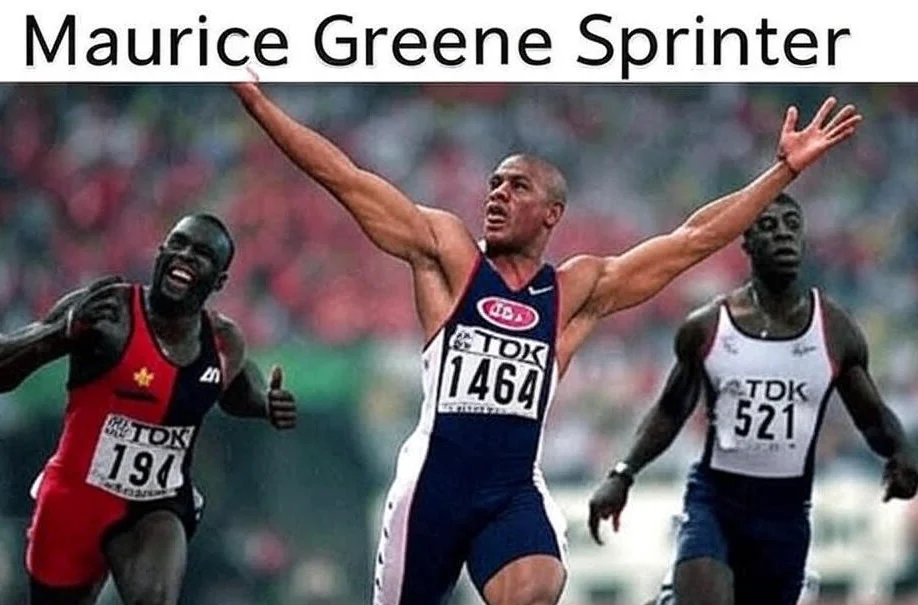The world of track and field has seen many great athletes, but few have dominated the track with the same intensity and charisma as the Maurice Greene sprinter legacy. Known for his explosive starts and fierce competitive spirit, Greene became the face of American sprinting at the turn of the millennium. His journey from a young athlete in Kansas to an Olympic champion is a story of determination, hard work, and an unshakeable belief in his own abilities. For years, he was not just a runner; he was the “World’s Fastest Human,” and his impact on the sport is still felt today.
This article explores the life and career of the iconic sprinter Maurice Greene. We will look at his early days, his groundbreakingly sprint technique, and the training that propelled him to greatness. We’ll also cover his impressive collection of medals, his life off the track, and answer some of the most frequently asked questions about this track and field superstar.
Table of Contents
The Rise of a Sprinting Sensation
Maurice Greene was born on July 23, 1974, in Kansas City, Kansas. From a young age, he showed incredible athletic talent, excelling in both football and track at F.L. Schlagle High School. While football was a passion, his true calling was on the track. His raw speed earned him a scholarship to the University of Kansas, but his early career had its share of challenges. He competed in his first major international event in 1995 but failed to qualify for the 1996 Atlanta Olympics. This disappointment became a turning point.
Feeling he needed a change to reach his full potential, Greene moved to California to train with the legendary coach John Smith. This move was crucial. Under Smith’s guidance, Greene refined his raw talent and developed into a technical master of the sprint. It was here that he joined the HSI (Hudson Smith International) training group, which would soon become famous for producing some of the world’s top sprinters. The disappointment of 1996 fueled a fire in him, setting the stage for a period of dominance rarely seen in the sport.
A New Chapter in California
The decision to train with John Smith transformed the Maurice Greene sprinter story. Smith was known for his analytical approach to sprinting, breaking down every phase of the race. Greene fully embraced this new environment. He learned to channel his power more efficiently and perfected what would become his signature start. The results came quickly. Just one year after failing to make the Olympic team, Greene shocked the world by winning the 100m title at the 1997 World Championships in Athens, defeating the reigning Olympic champion, Donovan Bailey. This victory was the official announcement of his arrival on the world stage. It was the beginning of an era where the name Maurice Greene would be synonymous with speed.

Analyzing the Maurice Greene Sprint Technique
What made Maurice Greene so fast? A huge part of his success was the revolutionary Maurice Greene sprint technique. He was a master of the “drive phase,” the initial explosion out of the starting blocks. Unlike other sprinters who would pop up quickly, Greene stayed low, keeping his head down for the first 30-40 meters. This technique allowed him to generate immense power and build momentum more effectively than his competitors. By the time he transitioned into his upright running form, he was already accelerating past the field.
His technique was a combination of raw power and precise mechanics. He had an incredibly powerful leg drive and a fast, compact arm swing that kept him balanced and moving forward. Watching a Maurice Greene sprinting montage reveals this perfectly. You can see the explosive power from the blocks and the seamless transition into top speed. His ability to hold his form and speed through the finish line, even under extreme pressure, made him a formidable opponent in every race he ran.
The Drive Phase Perfected
The drive phase was the cornerstone of Greene’s dominance. This is the part of the sprint right after the start, where the athlete’s body is angled forward, driving powerfully with each step.
- Low Body Angle: Greene maintained a forward lean for longer than most sprinters. This kept his center of gravity low and allowed for maximum horizontal force production.
- Powerful Leg Extension: Each step was a powerful push against the track, propelling him forward with explosive force.
- Delayed Upright Transition: He resisted the urge to stand up straight too early. By staying in the drive phase, he built up a speed that was hard for others to match in the later stages of the race.
This technical mastery, combined with his natural talent, made his start one of the most effective weapons in sprinting history.
The Intense Maurice Greene Sprint Training Regimen
Becoming the world’s fastest man doesn’t happen by accident. The Maurice Greene sprint training program was notoriously intense and designed to build explosive power, speed endurance, and mental toughness. Under coach John Smith, his training was a science. Workouts were meticulously planned, focusing on different aspects of the sprint. A typical training week would involve a mix of track workouts, weight room sessions, and recovery.
On the track, workouts included block starts, short sprints (30m, 60m), and longer runs (150m, 200m) to build speed endurance. Smith emphasized quality over quantity, ensuring every repetition was performed with perfect technique and maximum intensity. In the weight room, the focus was on explosive movements. Lifts like power cleans, squats, and plyometrics were essential for developing the power needed for his explosive start. This holistic approach ensured that Greene was not only fast but also strong and resilient enough to handle the demands of a long season.
A Glimpse into His Training
A well-rounded training plan was key to his success. Here are some core components of his regimen:
- Plyometrics: Box jumps, bounding, and other explosive drills to increase reactive strength.
- Strength Training: Foundational lifts to build overall power.
- Core Work: A strong core was vital for maintaining stability and transferring power efficiently.
- Flexibility and Recovery: Stretching, massages, and rest were critical for preventing injuries and ensuring he was ready for the next session.

A Collection of Gold: Maurice Greene Sprinter Medals
The ultimate measure of a sprinter’s career is often their collection of medals, and the list of Maurice Greene sprinter medals is truly impressive. He dominated the sport during his peak, winning major titles at the Olympics and World Championships. His ability to perform on the biggest stages cemented his legacy as one of the all-time greats.
His crowning achievement came at the 2000 Sydney Olympics, where he won the gold medal in the 100m, officially earning the title of “World’s Fastest Man.” He also anchored the USA 4x100m relay team to another gold medal. In addition to his Olympic success, Greene was a five-time World Champion. He won the 100m world title an incredible three times in a row (1997, 1999, 2001). At the 1999 World Championships, he achieved a historic “sprint triple,” winning gold in the 100m, 200m, and 4x100m relay.
Maurice Greene’s Major Championship Medals
| Year | Competition | Venue | Event | Medal |
|---|---|---|---|---|
| 2000 | Olympic Games | Sydney | 100m | Gold |
| 2000 | Olympic Games | Sydney | 4x100m Relay | Gold |
| 2004 | Olympic Games | Athens | 100m | Bronze |
| 2004 | Olympic Games | Athens | 4x100m Relay | Silver |
| 1997 | World Championships | Athens | 100m | Gold |
| 1999 | World Championships | Seville | 100m | Gold |
| 1999 | World Championships | Seville | 200m | Gold |
| 1999 | World Championships | Seville | 4x100m Relay | Gold |
| 2001 | World Championships | Edmonton | 100m | Gold |
| 1999 | World Indoor Championships | Maebashi | 60m | Gold |
Life Beyond the Finish Line
After retiring from professional sprinting in 2008 due to recurring injuries, Maurice Greene didn’t just fade away. He remained a public figure, exploring different interests and passions. He famously competed in the reality TV show Dancing with the Stars, where he showcased his charisma and reached the quarterfinals. He has also worked as a track and field analyst and ambassador for the sport, sharing his knowledge and experience with a new generation.
In his personal life, information about the Maurice Greene sprinter wife is something fans are often curious about. He is married to Latoya Greene. He often speaks about his family and how they keep him grounded. Today, he channels his competitive drive into coaching and teaching, helping to develop young athletes. He works as a physical education teacher and coach at a charter school in Arizona, passing on the lessons he learned during his illustrious career.
What is the Maurice Greene Sprinter Net Worth?
As one of the most successful and marketable athletes of his time, the Maurice Greene sprinter net worth has been a topic of interest. During his peak, he commanded large appearance fees and had lucrative endorsement deals with brands like Nike. While exact figures are private, estimates place his net worth in the millions. His financial success was a result of his incredible achievements on the track, his charismatic personality, and his status as a global sports icon. His earnings allowed him to secure a comfortable life after his sprinting career and support his family.
Physical Profile: Maurice Greene Sprinter Height and Build
The Maurice Greene sprinter height is listed as 5 feet 9 inches (176 cm). While not the tallest sprinter, his physique was perfectly suited for his explosive style. He was incredibly muscular and powerful, weighing around 180 pounds (82 kg) during his competitive years. This compact, powerful build was a key advantage, especially in the first half of the race. His lower center of gravity and powerful leg muscles allowed him to generate incredible force out of the blocks, creating the explosive start that so often left his competitors behind. His build was a testament to the idea that in sprinting, it’s not always about height, but about power-to-weight ratio and biomechanical efficiency.
Conclusion of Maurice Greene Sprinter
The legacy of the Maurice Greene sprinter is one of power, precision, and personality. He redefined what was possible in the 100m dash with his unique technique and unwavering self-confidence. His 52 sub-10-second runs and impressive medal collection speak for themselves, but his impact goes beyond the numbers. He was an entertainer who brought excitement to the track every time he competed. From his signature “GOAT” tattoo to his pre-race rituals, he captivated audiences worldwide. Maurice Greene wasn’t just a sprinter; he was a phenomenon who pushed the boundaries of human speed and left an indelible mark on the history of athletics.
Key Takeaways
- A Champion Forged by Setback: Failing to make the 1996 Olympic team was the catalyst that pushed Greene to become one of the greatest sprinters ever.
- Technical Master: His unique “drive phase” technique, where he stayed low out of the blocks, revolutionized sprinting starts.
- Decorated Champion: Greene is a two-time Olympic gold medalist and a five-time World Champion, dominating the sprint world from 1997 to 2001.
- Life After Track: He has successfully transitioned from athlete to media personality, coach, and teacher, continuing to contribute to the sports world.
- Lasting Legacy: More than just his records, Greene is remembered for his charisma and the excitement he brought to track and field.
Frequently Asked Questions about Maurice Greene Sprinter
Who is sprinter Maurice Greene?
Maurice Greene is a retired American track and field sprinter who specialized in the 100m and 200m events. He is a multiple Olympic and World Champion and a former world record holder in the 100m. He was considered the “World’s Fastest Human” during his peak in the late 1990s and early 2000s.
What was Maurice Greene’s 100m world record?
Maurice Greene set the 100m world record on June 16, 1999, in Athens, Greece, with a time of 9.79 seconds. This record stood for six years and cemented his status as the top sprinter of his era.
What is Maurice Greene doing now?
After retiring from athletics, Maurice Greene has been involved in various activities. He has appeared on television, including Dancing with the Stars, and worked as a track and field commentator. He currently works as a physical education teacher and coach in Arizona, mentoring young athletes.
How many Olympic medals did Maurice Greene win?
Maurice Greene won a total of four Olympic medals. He won two gold medals at the 2000 Sydney Olympics (100m and 4x100m relay), a silver medal in the 4x100m relay, and a bronze medal in the 100m at the 2004 Athens Olympics.

Leave a Reply